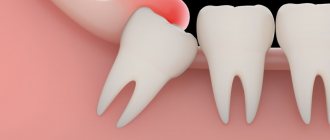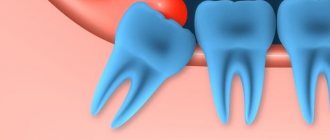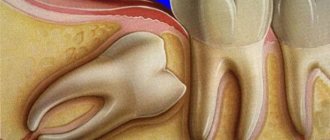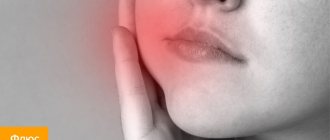The jaw of modern man is smaller than that of his ancient ancestor. This difference is 10-12 mm. The reason for the reduction of the jaw is a change in the nutritional pattern of living people. Food has become softer, carefully processed chemically or thermally. Therefore, the need for a large and powerful jaw disappeared. Wisdom teeth, which are located outermost in the dentition, have thus lost their practical use and become rudiments. Eights usually grow up later than others - between 14 and 25 years of age or later. Hence the wisdom-related name for the third molars, as dentists call them.
Every person has two rudiments of “eights” on the upper and lower jaw, but often there is not enough space for all the rudimentary teeth, and they cause a lot of problems. Wisdom teeth often fully erupt and not all become aligned. The figure eight may remain impacted, that is, hidden under the gum or bone, or may only partially erupt. The formation of third molars takes a long time. The growth of wisdom teeth can take years. Periods of growth usually alternate with phases of rest and development.
Unlike other teeth, eights do not have milk predecessors. In addition, it is very inconvenient to fully clean them due to their extremely difficult to reach position. All this leads to the development of pathological processes and difficulties during periods of their growth. Removing wisdom teeth is also considered a complex procedure with a high degree of trauma. The most common complaints that patients come to dentists with are swelling, inflammation and soreness of the gums near the “eight”. The causes of these uncomfortable phenomena are caries, pericoronitis, difficulties in the germination and eruption of wisdom teeth, as well as deep infectious and inflammatory processes in the root area and nearby tissues.
Painful eruption and incorrect position during germination
Periods of active wisdom teeth eruption often cause discomfort. Many people experience pain during this process, swelling and inflammation of the gum tissue. The reason for this manifestation is the absence of the previous milk tooth in the place where the figure eight grew. Third molars are forced to find a path of growth and break through dense bone tissue, which, given the large size of these teeth, becomes the cause of discomfort. Often, the lack of space for the normal position of the figure eight leads to its complicated germination.
In particularly difficult cases, the tooth takes on a dystopic position. It grows in an atypical direction, not upward, but at an angle. It causes injury to neighboring teeth and displacement of the entire dentition, up to bite deformation. A wisdom tooth growing horizontally can injure the cheek, tongue and roots of its “neighbors”.
Causes of inflammation
Inflammation of the gums near the eighth tooth is accompanied by pain and discomfort. To diagnose the disease, it is necessary to take an X-ray of the tooth and take a blood test. Based on the results of the studies, the doctor makes a decision:
- Remove the tooth.
- Prescribe therapeutic treatment.
- Or cut the gum.
The gums can become inflamed and painful, most often due to the incorrect position of the tooth, which has difficulty erupting and grows in the wrong direction relative to the dental arch. The number eight can take a very long time to erupt, up to several years.
How does pericoronitis occur?
If a wisdom tooth grows for a very long time or grows atypically, then partial gum loss above the surface of the tooth may occur. This creates a gum hood over the figure eight. This formed hood contains food debris that is very difficult to remove. They cause the proliferation of pathogenic bacteria, which ultimately leads to pericoronitis. In addition, if there is an upper double figure eight, then the gingival hood is constantly injured when biting, which becomes the cause of a non-infectious inflammatory process in the gum tissue. Pericoronitis can be acute (purulent or catarrhal) or chronic. Signs of pericoronitis:
- acute pain radiating to the neck or ear;
- soreness of the gum tissue during palpation and chewing;
- inability to open your mouth;
- purulent discharge;
- swelling of the mucous membrane;
- specific odor from the mouth;
- temperature increase;
- enlargement of the submandibular lymph nodes.
If the disease has taken a chronic form, then you will not have to wait long for noticeable painful manifestations. Pericoronitis regularly recurs with all the symptoms of an acute purulent form. Complications of untreated pericoronitis can be periostitis, abscess, osteomyelitis of the jaw or phlegmon. Therefore, if signs of pericoronitis are detected, urgent dental care is needed. The specialist, taking into account the phase and form of the disease, will select the appropriate treatment. Medication or surgery may be needed.
Causes of pain
An erupting tooth hurts for several reasons:
Development of pericoronitis. Above the wisdom tooth there is a hood of soft gum tissue that can completely cover the retracted element. This area is the hardest to clean at home. Gradually, food debris and bacteria accumulate on the gum near the wisdom tooth, triggering the inflammatory process. If assistance is not provided in a timely manner, the pathogenic flora spreads to periodontal tissue, causing damage to healthy tissue. The disease requires immediate surgical treatment. The essence of the intervention is that the doctor opens the hood and removes necrotic masses from there. The wound is treated with antiseptic drugs. After the intervention, the patient is prescribed antibiotics to prevent complications.
Incorrect growth of the last molar. This is the second most common reason for pain in the gums above the wisdom tooth. If there is not enough space in the jaw for the last element, then it begins to grow sideways, putting pressure on neighboring units or injuring the soft tissues of the cheek. In the second case, stomatitis develops and non-healing ulcers appear on the surface of the mucous membranes. Permanent damage to structures can ultimately lead to the appearance of a cancerous tumor. The treatment regimen in this case is determined by the doctor, depending on the characteristics of the problem.
In the photo, a wisdom tooth injures the mucous membranes of the cheek on the inside
Pain during the eruption of a wisdom tooth is often observed when swallowing, especially if the problem element is located on the lower jaw. At first, the symptom resembles the development of a sore throat, but in this case, discomfort is noted only on one side of the throat. Upon examination, the dentist can easily determine inflammation and swelling of the mucous membranes of the pharynx. On the part of the erupting tooth, inflammation of the submandibular lymph node is noted.
To alleviate the signs of pathology in the first days, it is allowed to use traditional medicine: decoctions of chamomile and sage, tincture of thyme and calendula. It is important that the liquids used are not hot. Heating the inflamed areas leads to the rapid spread of pathogenic bacteria to healthy mucous membranes. The purulent process that begins when heated is often complicated by periodontitis and osteomyelitis. For rinsing the mouth, it is better to use solutions at room temperature.
Why does my ear and head hurt when the last molar erupts? These signs indicate a progressive inflammatory process and the development of severe complications. With pathology, pain radiates to the ear, bridge of the nose, temples and neck. Gels containing lidocaine will help you cope with pain at home. The composition is used to lubricate inflamed gums. Drugs with a powerful anesthetic effect - Nise, Ketorol - can reduce the intensity of headaches.
Due to cutting eights, damage to the trigeminal nerve often occurs. The disease is accompanied by involuntary contraction of facial muscles and headaches. It becomes difficult for a person to talk and eat due to acute sensations. The problem cannot be dealt with at home by rinsing and taking NSAIDs. Inflammation of the trigeminal nerve must be dealt with in a clinic under the supervision of a specialist.
Neuralgic pain will appear until the surgeon removes the problematic tooth. If the unit is abnormally positioned, the roots of adjacent teeth may be destroyed, which can lead to malocclusion. The problem is often observed in cases where the last molar occupies a horizontal position.
Variation of the figure eight arrangement in the oral cavity
Why do my gums hurt when my wisdom teeth grow? In addition to the incorrect placement of the unit in the row, other factors that provoke the problem should be noted:
- Lack of space in the oral cavity. The jaws of modern humans have undergone changes due to dietary habits. Due to the fact that there was no longer a need to chew rough food, the jaw was shortened by 10-12 mm. Often the last teeth do not have enough space to appear on the surface, so they grow incorrectly, putting pressure on other elements, causing swelling of the cheek and an increase in temperature.
- Inflammation of the mucous pocket above the figure eight. Suppuration of the gums leads to inflammation of the problem area and the appearance of throbbing pain in the tooth.
- Secondary infection. Bacteria penetrate into the swollen gums from teething. The situation is noted when there are carious elements in the mouth. Pathogenic flora penetrates into the deep layers of soft tissue, causing gumboil.
- Eruption of caries-affected figure eight.
Why does my jaw hurt when the last molars emerge? The discomfort is due to the fact that eights do not have predecessors, like other molars. The gums in this place are very dense, so wisdom teeth come out very painfully.
Infectious and inflammatory processes, caries
The hygiene of wisdom teeth is complicated by their inaccessibility, so they are prone to various dental diseases. Due to incomplete eruption, specific structure and prolonged germination, eights are predisposed to various painful conditions:
- Caries is a common disease that also occurs in impacted eights. Very often, wisdom teeth erupt with signs of crown destruction, even if they have been under the gum tissue for a long time.
- Complications of caries - periodontal cyst, pulpitis, periodontitis.
- Acute purulent-inflammatory processes - fistula, flux and abscess.
Prevention
To prevent problems associated with wisdom tooth growth, the following measures should be taken:
- Timely visit to the dentist . Even in the absence of complaints, it is necessary to conduct an oral examination at least twice a year to identify possible diseases.
- High-quality teeth cleaning . Teeth should be brushed thoroughly twice a day for at least three minutes. Once every three months it is necessary to replace your toothbrush.
- Delivery of essential vitamins and minerals to the body . You need to eat foods rich in calcium, phosphorus and vitamin C.
Many experts recommend removing a wisdom tooth when it grows incorrectly. In this way, maximum treatment effectiveness is achieved. But patients are not always ready to take such a step, since there is an opinion that “a person cannot have extra organs.”
Indeed, the “eight” may prove useful in the future, when it is necessary to secure a denture if other teeth are lost.
The “third molar” is cut at a later age, which means it begins to deteriorate much later, which allows it to withstand the load of the prosthesis, which the rest of the teeth are no longer capable of.
Often, when the erupting wisdom tooth is potentially in the correct position, the doctor suggests getting rid of not the tooth, but the “hood”, which can lead to inflammation. This procedure is simpler and safer. For the patient under local anesthesia, the excess part of the gum is simply cut off. In the future, you will need to use antiseptic solutions and ointments prescribed by your doctor for some time. But the tooth will now be able to develop unhindered in the oral cavity.
First aid
Before going to the dentist, you can relieve pain at home using certain pharmaceutical products.
- Drink a painkiller drug - Nimid, Nice, Analgin, Ketanov, Paracetamol, Tempalgin.
- Place the turunda on the swollen area with a special ointment or gel - Kamistad, Dentinox, Metrogyl-Denta, Cholisal.
- Rinse the mouth with antiseptic solutions - Miramistin, Chlorhexidine and Furacilin.
You can use home help methods for three days. Next, the supervision of a professional doctor is necessary. If the pain does not go away and the swelling does not go away, then you should immediately visit a dentist to find out and eliminate the cause of the painful condition. Inflammation during pericoronaritis is relieved by washing the gingival hood with pharmaceutical antiseptic solutions: Iodopharm, Potassium permanganate, Furacilin.
Symptoms of wisdom tooth inflammation
To prevent a problem, you need to immediately notice the symptoms that cause it. To do this, special attention should be paid to the following points:
- there is a prolonged tugging pain;
- the gums become hard;
- the adjacent tooth becomes loose;
- body temperature rises;
- lymph nodes enlarge.
To alleviate his condition, the patient can take an analgin or paracetamol tablet at home before visiting a doctor, rinse his mouth with an antiseptic, and use only liquid food for nutrition.
If the pain is severe, you can take a painkiller pill, but you cannot suppress the pain with pills for a long time. You still need to go to the dentist.
Traditional medicine methods
Folk remedies can be auxiliary methods for eliminating inflammation in the early stages. At the initial stages they are able to give excellent results. There are herbs, decoctions and infusions of which can have anti-inflammatory, disinfectant, wound healing and antimicrobial effects. To get such a decoction, you need to pour a teaspoon of beneficial herbs with a glass of boiling water and let it brew. Next, the resulting substance is filtered and the inflamed area is rinsed 4-6 times a day. Healing plants in this situation are chamomile, lemon balm, oak bark, calendula, sage and St. John's wort. A weak soda-salt solution can also have an anti-inflammatory effect. You need to rinse your mouth with it three to five times a day.
Treatment of tumors of the cheek and gums near the wisdom tooth
If there are signs of disease or swelling of the cheek, it is recommended to immediately consult a dentist. Prescribing the correct treatment by a competent specialist will help avoid health problems and the progression of the disease to a chronic condition. In a situation where it is not possible to immediately consult a doctor, you need to take measures yourself. First of all, if you have severe pain, you can resort to strong painkillers. These include:
- "Analgin";
- "Nurofen";
- "Nise";
- "Ketanov";
- "Took";
- "Tramadol".
Long-term use of tablets (more than 5-7 days) is dangerous and can lead to gastrointestinal bleeding.
A home remedy such as a solution of baking soda and salt can also help relieve pain. To do this, mix one teaspoon of baking soda and two tablespoons of salt. Dilute the mixture in 200 ml of water at room temperature. Next, you should rinse the painful area locally for several minutes.
In order to relieve inflammation, you can take one of the non-steroidal anti-inflammatory tablets:
- "Aspirin";
- "Ibuprofen";
- "Naproxen";
- "Ketoproven."
Cholisal
Specialized dental gels are also convenient to use, which will relieve inflammation and pain and facilitate tooth eruption. Such gels are:
- "Holisal";
- "Kamistad";
- "Dentol";
- "Panstoral".
Local rinsing with natural decoctions and tinctures of oak bark, chamomile, chicory root, lemon balm, and calendula also helps.
Specialist help
In case of inflammation of the gingival tissues around the eights, the best solution is to immediately visit a dentist. The specialist will conduct an x-ray and a visual examination of the condition of the tooth and the surrounding area. Based on the examination results, competent treatment will be prescribed:
- Medication - by prescribing antihistamines and anti-inflammatory drugs, antibiotics, special ointments and gels, antiseptic baths.
- Surgical - cutting the gum or gingival hood, removing the figure eight that caused the problem.
If inflammation is accompanied by unbearable acute pain and severe swelling of the gums, a specialist performs a novocaine blockade. Sometimes laser therapy is prescribed, which has an anti-inflammatory effect on the affected area.
High fever and pain due to inflammation of the hood
The eruption of the figure eight may be accompanied by general symptoms such as high fever, weakness, nausea, and lack of appetite. Such signs are associated with infection, so you need to consult a doctor, since treating intoxication at home is unsafe. First aid will be to drink plenty of fluids and take diuretics. A high temperature during the eruption of the figure eight can last for several days, so the doctor will individually prescribe antipyretics and tell you how to relieve pain and treat inflammation in the gum area in order to avoid unpleasant symptoms in the future. It is easy to remove inflammation and relieve pain at home, but this will only mask a serious disruption in the process of teething, so it is important to know the dangerous symptoms that require immediate consultation with a dentist.
When should you see a dentist if your figure eight is teething and your hood is inflamed?
- It is not possible to treat inflammation at home, and the symptoms only get worse;
- The gums near the figure eight are swollen, there is throbbing pain;
- It hurts to chew and swallow, the symptoms make it difficult to sleep at night;
- It is not possible to relieve pain in the gum area with analgesics;
- The gums around the figure eight swell, purulent exudate accumulates;
- The figure eight erupts incorrectly and puts pressure on the adjacent tooth.
What such phenomena can lead to without treatment, you will be told at the Leaderstom clinic, where consultation is not only free, but also saves the health of the eight and the entire dentition.
Help with inflammation after removal
Due to their inaccessible location, full or partial impaction, and large tooth sizes, removal of third molars is often painful and traumatic. If after surgery to remove figure eights there is severe swelling, and it is accompanied by increasing pain for more than three days, this may be a sign of a disease called alveolitis. It occurs due to the entry of bone fragments, pathogenic bacteria into the wound formed after extraction, or due to the blood clot being washed out of the hole too quickly.
Signs of alveolitis are sharp pain in the wound area, redness of the gums, swelling of the extraction site, absence of a blood clot in the first week after the removal procedure, purulent discharge, fever, enlarged submandibular lymph nodes, general weakness.
It is very important to treat alveolitis immediately. This condition, without proper help, can cause tissue necrosis, abscess, phlegmon and osteomyelitis. In addition, alveolitis can lead to blood poisoning. If there are any signs of this problem, an urgent visit to the dentist is indicated.
Swelling of the gum tissue around the wisdom tooth is the first signal about the development of complex and dangerous dental diseases. Therefore, it is important not to rely on self-medication, but to consult a specialist in time.
Why does swelling occur?
Edema is the excess accumulation of blood in the extracellular spaces of the body to speed up healing. If your cheek is swollen after wisdom tooth removal, there may be several physiological reasons:
- manifestation of an allergic reaction to the anesthetic;
- purulent focus of inflammation, usually eliminated before surgery;
- elongated roots of the tooth being removed,
- high pressure.
The listed factors are mainly individual for each organism. Most often, swelling of the cheek after wisdom tooth removal is a natural protective reaction to surgery. If no pathological factors are observed, and the dynamics of healing proceed as expected, then there is no need to worry.
If swelling occurs due to natural causes, this condition is considered normal.
How to determine natural origin?
- The tumor appears a day after the intervention.
- Pain and swelling gradually subside.
- Body temperature is normal or slightly elevated.
- Slight pain during swallowing or chewing processes.
Even if the tumor looks terrible, the first few days after surgery may be completely normal. You should be concerned if, after the allotted time, there is a tendency for pain and swelling to progress.











